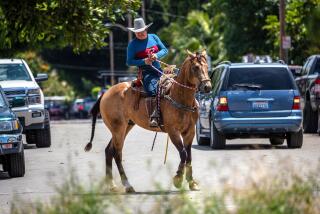4-Footed Ballet Puts On a Few Airs : Recreation: The Royal Lipizzaner Stallion Show at the San Diego Wild Animal Park showcases the horses’ dancing talents.
- Share via
You wind your way along the narrow path, through the dense growth of trees, ferns and scarlet blossoms. Kookaburra birds laugh as you pass. The unmistakable trumpets of unseen elephants herald your presence.
Then, amid the exotic jungle noises, there is another sound--the curious, lilting strains of a Viennese waltz.
The music grows louder. You emerge into sunlight. Before you are horses, pure white horses. Through a white trellised arch, they enter a grand arena and begin to leap, twirl and bow.
Welcome to the Royal Lipizzaner Stallion Show at the San Diego Wild Animal Park. The show, which runs daily at the park through Sept. 3, showcases the Lipizzaner stallions and the classical dressage movements the breed has made famous at the Spanish Riding School in Vienna, Austria.
It is a show of elegant music, much of it waltzes, and elegant horses--horses that seem to perform spontaneously, independent of their riders. This invisible communication between horse and rider, the melding of two into one, is the foundation of the classical dressage riding style.
The Lipizzaner stallions originally were taught to perform their intricate drills and leaps as fighting strategies on the battlefield.
Today, more than 400 years later, audiences can see these same carefully cultivated movements in the Royal Lipizzaner Stallion Show.
It begins with the pas de deux , a close order drill in which two riders ride in mirror-image precision, and gives way to other presentations of the horses’ talents and training.
Then the show takes off--and so do the horses. The stallions fly into an exhibition of their “airs-above-the-ground,” including the dramatic capriole , in which the half-ton horses appear to defy gravity as they leap into the air and pause there for a hefty moment.
For their finale, the grande quadrille , six riders and their mounts come together in an intricate ballet. The horses’ movements are tight and precise; they seem to take their cues from the music rather than the riders, who, as the announcer says, “give the illusion they are merely along for the ride.”
While the Lippizaners are no longer trained for ballet on the battlefield, they continue to be regarded as equine treasures. Visitors from around the world go to the Spanish Riding School in Vienna to see what the Walt Disney film by the same named called “the miracle of the white stallions.”
The Wild Animal Park’s Royal Lipizzaner Show features a Florida-based company of international riders that for 20 years has given American audiences a chance to witness some of this magic.
Under the guidance of head trainer Albert Gesierich from the Spanish Riding School, the troupe’s horses, purebred descendants of the Vienna stallions, are trained according to the same methods employed by the school. The training takes years, but in accordance with the school’s traditions, it is accomplished patiently and gently.
“In Europe, there are still old men and grandfathers who teach the younger people how (training) has been done for centuries,” said stable master Michael Jaeger.
Such devotion to training and tradition are what led to the Lipizzaners’ appearances at the park this summer. “We brought the Lipizzaners here for two reasons,” said park spokesman Joel Edelstein. “A lot of people here own horses, all kinds of horses, and a lot of them have an interest in dressage.
“But the show also meshes with our program because the Lipizzaner is a man-made breed, created by a process of selective breeding. This is the same thing we try to do here in our attempts to save endangered species. Through selective breeding, we can increase and utilize the gene pools.”
The Lipizzaner also has faced endangerment, even extinction. In one instance, the breed’s rescuer was Gen. George S. Patton.
Patton was in Vienna near the end of World War II. Not only did he agree to take the Spanish Riding School into U.S. military protection, but he also helped salvage many of the finest Lipizzaner bloodlines.
Patton granted permission for a daring evacuation of the Lipizzaners that had been sent to a stud farm in Czechoslovakia earlier in the war. The clandestine operation, conducted to bring the horses back to their rightful home in Austria before the fall of the Iron Curtain, was a success.
After the war, the Lipizzaner breeding program and the Spanish Riding School were painstakingly nurtured back to health. A tribute to the American efforts toward preserving the 400-year-old Lipizzaner breed has become part of the Royal Lipizzaner Stallion Show.
Admission to the Lipizzaner Stallion Show is included in the general admission price to the San Diego Wild Animal Park: $14.50 for adults and $7.50 for children ages 3 to 15. Children age 2 and younger are free. Show times are 1:15, 3:30 and 5:45 p.m. daily, with a 7:15 p.m. show Friday and Saturday. For more information, call (619) 234-6541.
More to Read
The biggest entertainment stories
Get our big stories about Hollywood, film, television, music, arts, culture and more right in your inbox as soon as they publish.
You may occasionally receive promotional content from the Los Angeles Times.










